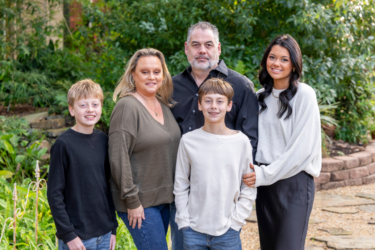The winter holidays are supposed to be a time for family, fun, and food especially, because let’s be honest, most of us probably dream about pumpkin pie and sugar cookies year-round.
However, around 6-7 percent of the U.S. population has a sensitivity to gluten, a protein commonly found in wheat, barley, rye, and pretty much any baked holiday good you can think of. Baking gluten-free (GF) during the holidays may seem like a daunting task, but luckily, Dr. Alice Hoyt, leader and founder of the Hoyt Institute of Food Allergy, is here to share some helpful tips on how to get through it.
What Are Gluten-Related Disorders?
Gluten sensitivity ranges from full-blown celiac disease with small bowel inflammation and damage, to allergies and the intolerance of gluten. General symptoms may include bloating, diarrhea, abdominal pain, tiredness, and skin rashes. A GF diet generally reverses or stops these symptoms. Dr.
Hoyt describes three of the most significant gluten-related medical conditions:
Wheat Allergy
“A wheat allergy is when you have an allergic antibody to wheat, and if you eat wheat, you react promptly–typically within minutes to a couple of hours–by experiencing hives, swelling, trouble breathing, and even vomiting,” says Dr. Hoyt.
Wheat allergy, the most common type of food allergy, can also lead to anaphylaxis. Anaphylaxis treatment is epinephrine, and treatment of the underlying allergy may include immunotherapy (like oral or sublingual options), and wheat avoidance. Immunotherapy helps build tolerance, making individuals either “bite-proof” or “free-eaters.” “Bite-proof” means the person won’t have an allergic reaction if they accidentally take a bite of a wheat-containing food. “Free-eaters” can eat as much wheat as they want without reacting.
Celiac Disease (CD)
This is an autoimmune disorder that causes your immune system to attack gluten in your small intestine. The attack can damage your gut and stop it from working properly. This is why people may experience abdominal pain, diarrhea, and other nutritional deficiencies. Since CD is an auto-immune disorder, other symptoms, such as rashes, can also occur. The treatment for celiac disease is gluten avoidance.
Non-Celiac Gluten Sensitivity (NCGS)
Simply put, this is a gluten intolerance and occurs whenever someone becomes sick after ingesting gluten. People with NCGS may experience brain fog, bloating, abdominal discomfort, tiredness, or diarrhea. CD should be ruled out before NCGS is diagnosed.
Fun Fact: You can be allergic to exercise!
There is such a thing as a rare, but potentially severe, wheat-dependent, exercise-induced anaphylaxis (WDEIA) food allergy. This basically means that yes, you can be allergic to exercise! Dr. Hoyt says that in WDEIA, one of the most common allergens is wheat. For example, this can mean a person can eat a regular piece of bread any time of the day, except when they are about to exercise or just exercised.
“Something about the exercise plus the wheat predisposes them to having anaphylaxis. Other times they can eat wheat with no problem,” says Dr. Hoyt.
Avoiding Gluten in the Kitchen
One of the biggest issues you can face when baking GF is cross-contact, sometimes also called cross-contamination. If you’re baking in a kitchen with gluten-containing ingredients nearby, it can be easy to mix up your safe ingredients with the dangerous ones (e.g. Mixing gluten-containing brownies in your favorite mixing bowl, then not cleaning the bowl before making gluten-free brownies). In the world of gluten- and wheat-avoidance, even small amounts matter.
“You really just want to use good cleaning practices,” Dr. Hoyt says. “If you’re in a commercial kitchen, then ideally, have a separate area where you are preparing allergy-free or allergen-friendly dishes. If baking at home, then use completely separate bowls and utensils, and make allergy-friendly treats first. Both of these strategies help make GF food prep much easier.”
Dr. Hoyt is also thankful that nowadays, there are a lot of premade GF baked goods sold in grocery stores. You can find almost anything GF from boxed baking products, like cake mixes and brownie mixes, to one-to-one baking flour mixes.
“Ten years ago, GF products were not nearly as big of a thing,” she adds. “It’s great to have more options.”
She finds it amazing how now, the GF options are much more prevalent than what they were then, and if you want to contribute something to a bake sale, you don’t have to be a chemist to figure out how to make something GF.
Where to Find Help
Dr. Hoyt recommends talking with your healthcare provider, including a board-certified allergist, if you think you may have any issues related to gluten or if you’re dealing with a wheat allergy. If you have already been diagnosed with CD, you should be consulting with a gastroenterologist (GI) regularly.
Dr. Hoyt says it is extremely important to work with a registered dietitian too. She explains, “A registered dietitian is somebody who has had rigorous academic study in dietetics and has completed a dietetics internship after graduating. Ideally, your gastroenterologist has a registered dietitian that they trust to help you navigate celiac disease.”
According to Dr. Hoyt, these are exactly the kinds of resources you need for your GF journey.
How to Stay Positive
Again, the holidays can be quite stressful for those living GF. Many of your friends and family are probably hosting parties and other gatherings during this time, and you may think you can never know what to expect when it comes to safe food options. If you can relate, here are some final tips and words of encouragement from Dr. Hoyt:
Plan Ahead
The more you can plan and be aware of what to expect on the menu, or what accommodations are being offered, the more fun your outing will be. While Dr. Hoyt notes how this can be hard sometimes, it’s still worth trying for.
“People who have these issues really don’t like to think about it ahead of time because we don’t like to think about it, right?” says Dr. Hoyt. “We just want to go and have a good time like everyone else.”
Have a Conversation
If you plan on attending any family member’s or friend’s get-togethers, then have a chat with them first. This way, you can get a feel for the menu and maybe even volunteer to contribute your own safe food items. You don’t want to get stuck eating GF foods you don’t like, which is why talks like these are so important. Remember, if someone’s hosting a party, it’s because they want guests to have a good time, so it’s okay to bring up these issues ahead of time as your family and friends will likely be willing to work with you.
Eat Before You Go
If you weren’t able to talk with your party host, it’s always a good idea to eat something before you head out. You may not know what safe foods will be available to you later, and if there is going to be alcohol at the party, it’s especially important to have eaten a safe meal beforehand. Dr. Hoyt also suggests always packing safe snacks, like GF protein bars to keep you going throughout your night.
Don’t Be Discouraged
There are plenty of doctors and specialists out there who want to help you, from your regular physicians to allergists, GIs, and registered dietitians. All it takes is talking with somebody who understands adverse reactions to foods to keep you on track for a happy and healthy lifestyle.
“It’s so important to see somebody who is going to present you with evidence, who’s going to hear you, and who is going to try to identify what your symptoms are in order to form a diagnosis,” expresses Dr. Hoyt. “This is so they can give you good treatment and you can live a life of less stress and more joy.” ■





